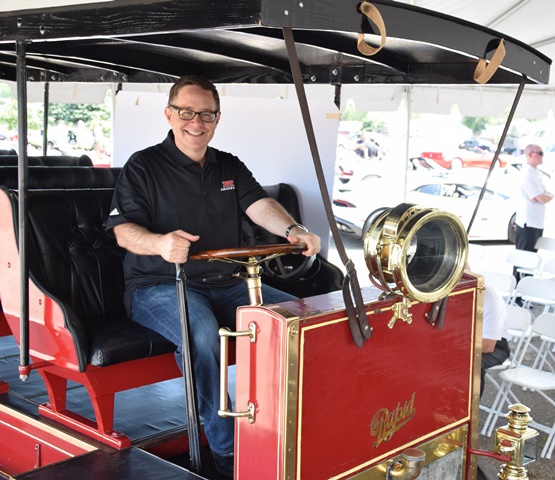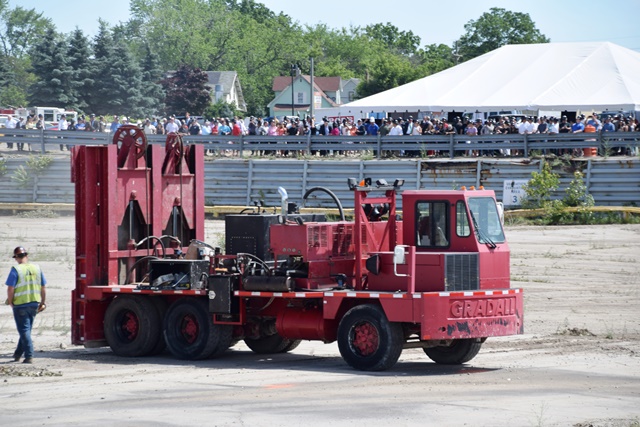PONTIAC, MI – A car collection needs space, and this old hub of automotive production has it.
Those with big wallets and a seemingly uncontrollable desire for fine sheet metal and models of historical significance can end up stashing them in multiple locations, such as a custom-built garage, the nearby EZ Storage or a PODS enclosure, and might even pay more for the accommodations than the vehicles themselves.

Collectors in other parts of the country, such as Southern California, Las Vegas, Minneapolis and Monticello, NY, now can store their vehicles in what is best described as a “car condominium” that also comes with a private handling track for owners who want to flail their prized possessions in controlled conditions without speed limits.
Michigan doesn’t have such a complex yet. But construction of the M1 Concourse is under way in this town 30 miles (48 km) north of downtown Detroit, and the track and the 80 private garages (already sold) are expected to be ready for owners by next spring.
The 87-acre (35-ha) parcel is on the northwest corner of Woodward and South Boulevard, where General Motors assembled pickup trucks, SUVs and, long ago, buses and recreational vehicles, until the plant was shut down in 2006 and torn down a few years later.
This land has a rich automotive history. In 1902, the Rapid Motor Vehicle Co. was founded here and began assembling trucks, such as the 12-passenger Pullman, four of which remain in existence today. One of them, from 1907, was on display at the M1 Concourse groundbreaking this week.
In 1909, GM bought Rapid, which was considered the predecessor of the GMC truck brand.
Repurposing Former GM Plant
GM had to unload the land as part of its 2009 bankruptcy, and it became part of the RACER trust (short for Revitalizing Auto Communities Environmental Response) along with 314 other properties in 14 states.
GM cleaned up the site before the sale to Brad Oleshansky, founder and CEO of the M1 Concourse. For good measure, his team drilled 240 holes on the property to ensure there were no environmental hazards needing to be addressed.
Is there a more appropriate way to revitalize an abandoned, weed-infested slab of concrete than by cleaning it all up and building a 1.5-mile (2.4-km) performance track to host a high-speed parade of Corvettes, Ferraris, Hellcats, Porsches and exotics of various vintage?
With six corners, several elevation changes and a straightaway of about 1/3 of a mile (0.5 km), Oleshansky expects the track to meet its customers’ need for speed and dynamic challenges. Top speed will be about 140 mph (225 km/h).

The 44-year-old entrepreneur sold his digital marketing business in 2008 to pursue this project fulltime. “I was looking for 8-10 acres (3.2-4 ha) for car condos and ended up with 87 acres,” he says. “So we started thinking about adding other things like the track, offices, retail. It organically grew.”
He closed the deal with RACER for the land seven months ago. With that much land, Oleshansky says the M1 Concourse can fit up to 250 private garages, depending on size.
The typical unit is 1,100 sq.-ft. (102 sq.-m), costs $240,000 and can fit up to seven vehicles as well as a second-floor loft for an office, entertainment space, kitchen, bathroom, man cave or diva den. The smallest unit is about half the size and can fit up to three vehicles.
So far, the 80 sales have generated more than $15 million in revenue. Some customers are buying multiple garages. One unit already sold is 5,000 sq.-ft. (465 sq.-m) and will hold 25 cars.
Some Customers Have No Cars
People can use the space how they like – to wrench on vehicles or admire them. The garage door opens to the track, so people can watch the action from inside.
“The track will be great for enthusiasts,” Oleshansky says. “There’s a huge need in the marketplace from automakers and aftermarket suppliers for a private track for testing, training and marketing purposes.”
The track also will be used for driving schools, autocross, winter driving schools and performance driving. “Everything but racing,” he says. “There won’t be car-against-car racing.”
To date, the customer base is men, women and corporations interested in storing classic, exotic and muscle cars. “We also have people who don’t even have a car,” he says. “They just want to use it as a hobbyist space.”
Zoned for mixed-use development, the parcels cannot be used as a primary residence. Most of the initial customers live within one hour of the site, but some are coming from Grosse Pointe, Brighton, Northville and Windsor, ON, Canada.

For the next few months, crews will clear the entire site of concrete and asphalt. “We will grind it all up and use it as base for the track and our buildings,” Oleshansky says. “We’re reusing everything onsite.”
The M1 Concourse will host events for the public throughout the year, and a corner of the property at Woodward and South Boulevard is being developed as an “experiential retail destination” geared to car enthusiasts.
“We want to create a place where every night of the week we can have a different car event,” he says.
Oleshansky knew metro Detroit, which gave birth to the auto industry, would be an ideal location for this project when he started researching the number of classic cars in the region.
“There are 62,000 of them in metro Detroit,” he says. “It’s the largest market in the world.”




